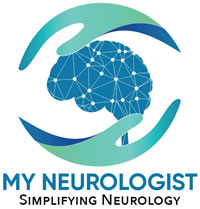Optic neuritis means inflammation of optic nerve, usually one, but it can be of both.
What are symptoms of ON?
It typically presents with relatively sudden visual loss (hours to days), with pain within or behind the eye, especially upon moving the eye. If there is no pain, an alternate diagnosis should also be entertained.
How is ON diagnosed?
Following measures are used to make the diagnosis, and to find its cause:
- Clinical history: Relatively sudden visual loss with pain in or behind the eye.
- Bedside examination: Patient typically has incomplete loss of vision in the affected eye, which can sometimes be profound. Color perception is also affected, especially of the red color. A simple bedside test with a flashlight can help determine if enough light signals are passing through the nerve or not, resulting in Afferent Pupillary Defect.
- Visual Evoked Potentials (VEP): It is also a simple non-invasive test. Patient is asked to fixate vision on a fluctuating checkered screen. Signals traveling from the eye to the back of the brain are traced, and averaged. In optic neuritis, signals passing through the optic nerve are slowed compared to the normal standards, which indirectly confirms an injury to the nerve. This test does not provide the reason for the slowing or the injury.
- Magnetic Resonance Imaging (MRI): In many cases, especially in acute settings, MRI may help visualize the abnormal optic nerve. Brain and spinal cord MRI can help to assess risk of Multiple Sclerosis, a common cause of optic neuritis in young patients.
- Optical Coherence Tomography (OCT) and Angiography: These are imaging tests performed at ophthalmology office. They can help image the nerve, and the supplying blood vessels.
- Lumbar puncture (LP): This is useful to determine the cause of optic neuritis.
- Blood tests: Blood tests are also performed to look for a cause for optic neuritis.
What are different causes of ON?
A: Conditions due to a problem with immune system:
- Multiple sclerosis
- Neuromyelitis Optica (NMO) spectrum disorder
- Sarcoid
- Sjogren Syndrome
- Systemic lupus erythematosus
- MOG-IgG
- GFAP-IgG
- Granulomatosus
- Paraneoplastic
B: Conditions due to an infection
- Neuroretinitis
- Syphillis
- Lyme disease
- Tuberculosis
- Viral infection
- Cat scratch disease
How is ON treated?
ON caused by immune dysfunction is treated with high dose of steroids given intravenously for 3 days, followed by a tapering dose of oral steroid (prednisone). The purpose is to eliminate inflammation ASAP to avoid or minimize permanent damage to the nerve. For patients allergic to steroids, or with high and uncontrolled blood sugar, SC ACTH (subcutaneous injection of adrenocorticotrophic hormone) is another option. Oral steroids alone are not effective treatment for ON. In patients who do not improve much with high dose IV steroid treatment, plasma exchange or plasmapheresis may help. Efficacy of IV-Ig is unclear. In patients with a chronic inflammatory condition such as sarcoid or lupus, further long-term treatment is also needed.
Patients with an infection causing ON, antibiotic or an antiviral drug may be the main medicine. In acute setting, steroid treatment can also be used, but with caution.
What is the prognosis of ON?
If diagnosed and treated quickly, majority of patients usually recover majority of visual loss.
Where can I get more information about ON?
American Ophthalmology Association


Leave a Reply
Your email is safe with us.
You must be logged in to post a comment.